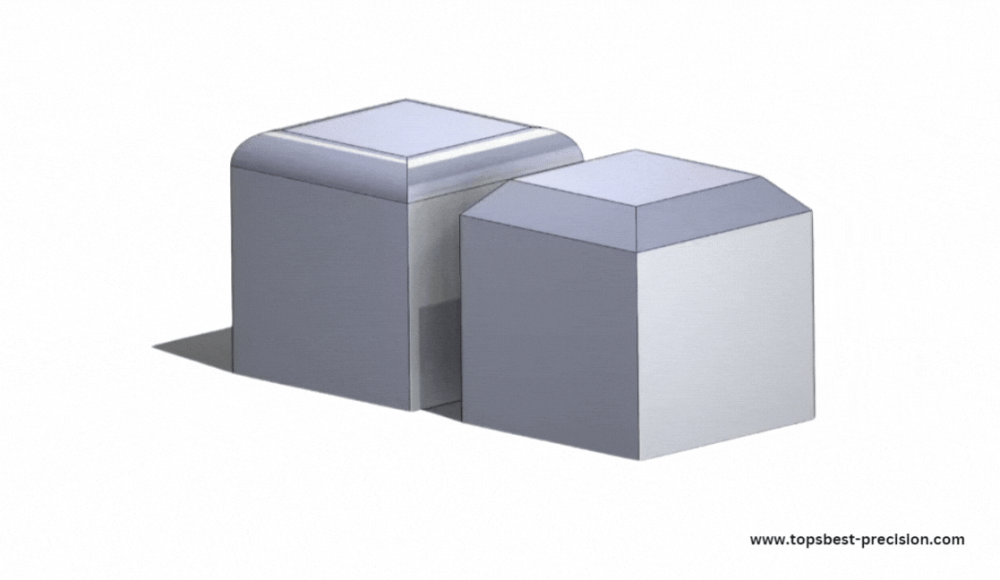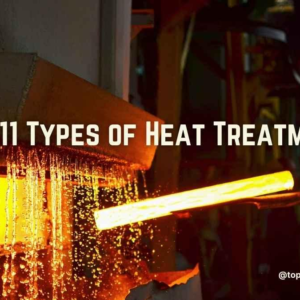Edges are as important for part designs for assembly as for other features, regardless of their size. Even a slight deviation in the edge between two components may affect their fit. Types of edges such as chamfers and fillets present different benefits that improve the part positioning and its mobility.
Chamfers are slopes between two parts, used to minimize rapid change in the contour and minimize stress. For reducing stress at the junctures of fillets where two surfaces are joined, fillets are optimal. These parts are subjected to heavy loads and cyclic use. So, it’s crucial to know when to use fillet and when to use chamfer. Let’s get into it.
Understanding Fillets
In mechanical design, fillet means the rounded areas of a part, which may be internal or external to the edge. Fillets are usually applied by machinists on these edges to minimize stress on parts. There are primarily three types of fillets used in engineering: miter, concave, and convex. Internal edges have fillets, usually concave while external edges have convex fillets.
The primary reason for applying fillet is to spread the load across a larger surface area so that there is no localized load concentration which results in early failure. Furthermore, where edges have to be broken and stress has to be reduced, fillets are the ideal solution for both strength and smooth transition of the parts.
Defining Chamfers
A chamfer is a break. It’s defined as a taper or a bevel made to the corner of a part while a fillet is a curved break. Chamfers are normally straight and are intended to provide a rapid change of direction of the edges of two surfaces. They are especially helpful in those areas which are subjected to rather high loads at the edge as they allow better control of stress concentrations.
Moreover, chamfers are often used on both the inner and outer edges of components. They are normally done at 45-degree angles. They appear to be handy when it comes to the finishing edges of holes after drilling and ensuring the neat fit of the screws-head. In addition, chamfers are used in the design of components where clear and well-defined edges are required because they can endure the stress distribution much better than fillets. For example, the use of bigger chamfers at such angles as 60 degrees is recommended especially when aligning bolts/screws.
Design Considerations for Fillet Vs. Chamfer
Determining, whether to use fillets or chamfers in a design is critical because both affect the functionality and the project cost. The right decision leads to increased efficiency of the part while the wrong decision leads to increased costs and reduced useful life of the component. The ultimate choice is mainly based on the features of the design of the part and its production feasibility.
Chamfer for Holes and Fasteners
When making holes for fasteners such as bolts or screws, a chamfer is perfect. A chamfer has a slope that leads the fastener into the hole without much struggle when inserting the fastener. However, when it comes to the application of a fillet in these cases it may hinder the free movement of the pin. Thus, the chamfer is preferred for applications for ease and efficiency of the fastener.
Safety and Sharp Edges
Deburring is essential to avoid accidents and to increase components’ durability. The use of fillets is optimal for creating a surface change while chamfers can be used for the elimination of sharp edges. In addition, engineers employ chamfers to design a slight interruption of the sharp edges. So, the users have a way of avoiding sharp and imperfect surfaces.
Outside Edges
While using both fillets and chamfers, are mostly applied to the external edges of the part under consideration, depending on the functional and/or aesthetic design requirements. Chamfers are most often applied for rounding sharp corners while fillets offer a smoother and rounder corner that can be aesthetically pleasing. Moreover, fillets can minimize stress concentrations.
Stress Relief with Fillets
Fillets are normally used where stress relief is required particularly at the margins of the component. The rounding-off of the edges of fillets helps to spread the stress uniformly. The size of the fillet radius is critical – the larger the fillet radii, the less stress is relieved, however, these parameters influence the part’s appearance, and performance.
Internal Corners in CNC Machining
CNC machining is characterized by using cutting tools. It’s extremely challenging to produce sharp internal corners due to the spinning tool nature. Therefore, fillets are obligatory for these zones. It is advisable to use a fillet radius greater than cutting tool to reduce the chances of wearing the tool during the machining process.
Chamfered Surfaces
Chamfers are normally applied on inclined planes at certain angles especially when joining parts or where aesthetics are required. They give a clean and neat appearance and are mainly used to de-sharpen edges. Additionally, chamfers are used for lead-in on threaded holes and deburring.
Fillets on Angular Surfaces
For the parts with angular or sloped surfaces, in the 3-axis machining generally, the fillets are added to make a smooth transition between edges. Fillets can improve the aesthetic appeal of the part and also provide additional strength, as it give a round look that is more pleasing to the eye.
Deciding on Fillet Radius
The right selection of fillet radius is crucial, since, it indirectly affects the part’s performance. A larger radius aids in stress distribution which reduces the chances of part failure however it makes the design a bit challenging.
Differences Between Fillet and Chamfer
It is crucial to know the differences between fillet and chamfer when it comes to designing and manufacturing products. Here is a table that shows the comparison between fillet and chamfer which will help the readers to differentiate between the two.
Table: Fillets Vs. Chamfers.
| Parameter | Fillet | Chamfer |
| Machining Cost | Fillets are typically more expensive due to the additional machining complexity and time required for curved surfaces. | Chamfers are more cost-effective, as they involve simpler cuts and require less precision than fillets. |
| Machining Time | Creating a smooth, curved edge requires more time, especially for large radii. The typical machining time for a fillet can increase by 20-30%. | Chamfers take less time to machine, often reducing machining time by 10-15% compared to fillets, making them faster to produce. |
| Cutting Tools | Fillets require specific radius tools, often leading to tool changes based on the desired curvature. Standard tool radius ranges from 2-5 mm. | Chamfers can be machined using standard cutting tools. A single tool can produce chamfers at various angles, such as 30°, 45°, or 60°. |
| Stress Distribution | Fillets distribute stress over a larger surface area, reducing stress concentration by approximately 50% compared to sharp edges. | Chamfers focus stress on smaller areas. Stress concentration at chamfered edges can be 1.5-2 times higher than that of a filleted surface. |
| Aesthetic Appearance | Fillets provide a smoother, more visually appealing transition between surfaces, ideal for parts requiring a polished look. | Chamfers offer a more technical, sharp-edged appearance, often used for parts where aesthetics are less of a concern. |
| Safety | Fillets create rounded, smooth edges, making parts safer to handle, and reducing the risk of injury by up to 90% compared to sharp edges. | Chamfers leave sharp corners, which can pose safety risks during handling. Extra care is needed to avoid potential cuts or abrasions. |
Solutions to Minimize Costs of Fillets and Chamfers
Fillets and chamfers enhance both the form and functional fit of a part. But, they increase the time needed to machine the part and hence the cost of production. Here are some ways that can be adopted to reduce these costs:
1. Minimize Tight Tolerances
The more precise, and simplest the design, the better they appear. Apparently, the higher the tolerance limits are set the higher the production costs might be when it comes to the inspection of chamfers. As it has been mentioned above, it can be allowed to have slightly larger tolerances for dimensions, and, therefore, it is possible to reduce the frequency of inspection and the costs for it.
2. Evaluate Production Volume
The factors that provide economic advantages to the chamfers or fillets depend on the quantity of parts manufactured. In particular, fillets, or chamfers, when used in the production of a small number of parts, are not very economical. As each part is relatively expensive. However, when producing parts on a larger scale, the marginal cost per unit is comparatively less, so here it’s logical to apply chamfers or fillets.
Deciding between Fillet and Chamfer: Areas of Concern
The choice between a fillet and a chamfer is often difficult for machinists to make. Below are key considerations that will help you in your decision-making process.
Machining Time
In situations where the size of chamfers does not allow the use of special equipment, chamfers are normally easier to make manually. But in CNC machining, the time difference is not very significant, it is mostly about tool replacement rather than the processing time.
Cost
As a rule, chamfers are less expensive in comparison with fillets. In terms of the costs, it is possible to state that using chamfers is more beneficial if costs are viewed as a major concern for the given project.
Attractiveness
Chamfers are sometimes replaced by fillets because they give a better look to the design compared to chamfers. Industrial designers use fillets quite often because these kinds of shapes look very good when incorporated into the design of a product.
Rust Resistance
Fillets can do a better job of preventing the occurrence of accelerated rust than chamfers. It enables the uniform thickness of the layer, important while applying thick layers so that they bond well to the base for anti-corrosive coatings.
Stress Distribution
In the case of designs that need equal stress distribution then fillets are useful. It disperses stress over a larger area, and the risk of having weak areas as compared to chamfers is minimal.
Functionality of Holes
If the purpose of holes in your design is different, then your decision will be different. If the hole is to receive pins or to drive screws and bolts, chamfers are generally the better in functional utility.
Conclusion
Fillets are very useful in minimizing stress concentration thus averting deformation while chamfers offer flexibility in mating parts. Knowledge of the distinctions between fillets, and chamfers, is crucial in determining the design and the subsequent processes that would be appropriate for the particular project. It can result in the effective and efficient generation of high-quality results at a lesser cost.
If you are still in doubt about whether to go for fillets or chamfers, our engineers will guide you on which way to go with your machined parts. Upload your CAD files today, and let’s start your project now!






2 thoughts on “Understanding the Difference Between a Fillet and Chamfer”